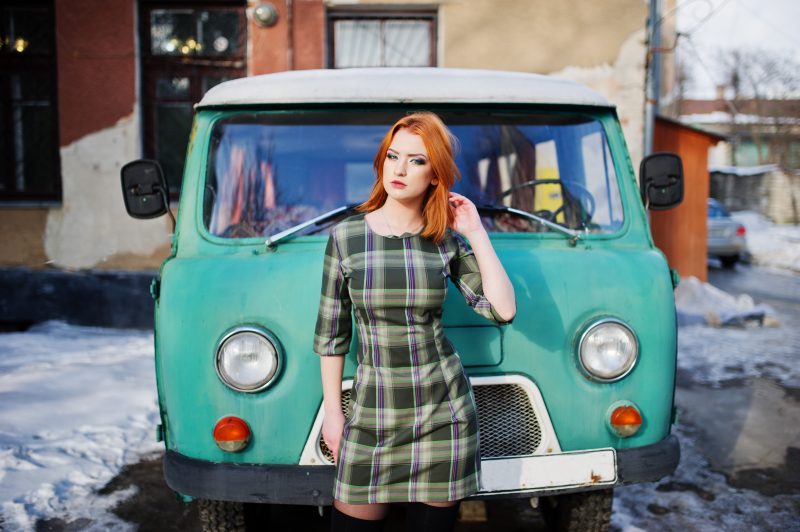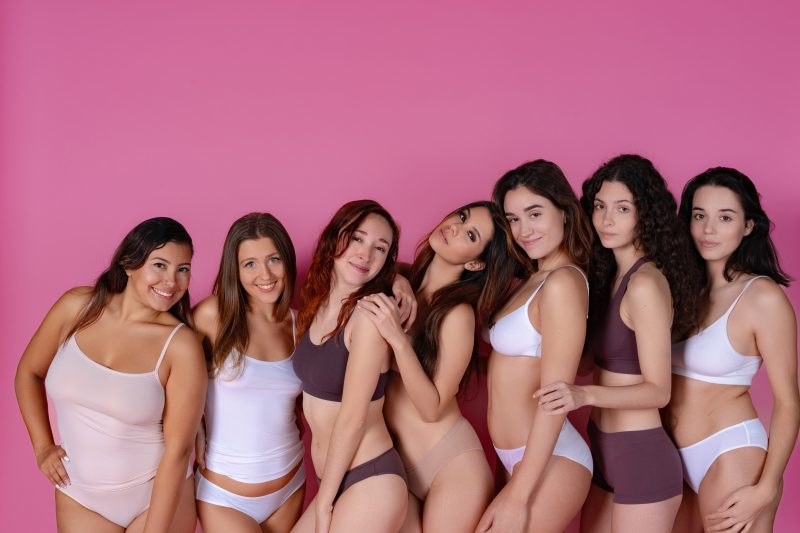I found it during a studio visit in Hackney – a workroom filled with natural light and the rhythmic sound of industrial sewing machines. A woman in her sixties was cutting fabric with the kind of precision that comes from decades of practice, while two younger apprentices watched intently. As the designer walked me through her collection, she gestured to a simple wool jacket hanging on a rail – beautifully made, with the kind of finishes you rarely see on the high street anymore.
“That’s one of ours,” she said with quiet pride. “Cut, sewn, and finished right here in London. The wool’s from Yorkshire, buttons from the Midlands.
Costs me twice as much to make it this way, but…” she trailed off, running her fingers along a perfectly executed seam.
“But it’s worth it,” I finished for her.

She nodded. “Always has been.”
It was a moment that’s stayed with me – not just because the jacket was gorgeous (though it was, and yes, it came home with me despite costing roughly the same as my monthly food budget), but because it encapsulated something I’ve been thinking about more and more: what does “Made in Britain” actually mean in fashion today, and why does it matter?
The story of British manufacturing is, in many ways, a story of loss. What was once a powerhouse of global textile production has dwindled to a fraction of its former size. The mills of Manchester, the knitwear factories of the Midlands, the shoe workshops of Northampton – many have closed their doors as production shifted overseas in search of cheaper labor and higher profits. Towns and cities built around textile industries have had to reinvent themselves, sometimes successfully, sometimes not.
But it’s also a story of survival, adaptation, and surprising resilience. Because despite everything – despite fast fashion and offshore production and reduced consumer expectations – there are still people making clothes in Britain. Really good clothes, in fact. From one-person studios to small factories employing skilled craftspeople, domestic manufacturing hasn’t disappeared; it’s just changed shape.
My first meaningful encounter with British-made fashion came during university, when a tutor arranged a field trip to a knitwear factory in the Scottish Borders. I’d had some vague notion of heritage mills producing tweed and tartan for tourists, but what we found was something else entirely – a modern facility combining traditional skills with cutting-edge technology, producing knitwear for some of the most exclusive brands in the world.
The factory manager, a no-nonsense woman named Margaret with a formidable knowledge of both mechanical engineering and fine-gauge knitting, walked us through the process. “See this machine?” she said, patting what looked like an enormous metal loom. “Cost more than my house. Could run it in China for a quarter of what it costs here. But they don’t have sixty years of collective experience on the factory floor, do they?”
She showed us a cashmere jumper they were producing for a French luxury brand – identical, she pointed out with a certain gleeful pride, to the ones they made for a high-street retailer at a third of the price, just with different labels sewn in. “Quality’s quality,” she shrugged. “Only difference is what someone’s willing to pay for the name.”
That visit was a revelation. I’d assumed, like many people, that British manufacturing was a nostalgic concept rather than a viable industrial practice. What I discovered instead was a shadow industry – smaller than in its heyday, certainly, but still producing world-class garments, often flying under the consumer radar because the brands they manufactured for didn’t emphasize the “Made in Britain” aspect of their production.
In the years since, I’ve made it something of a personal mission to seek out labels that not only manufacture in the UK but make this fact central to their identity. These aren’t just brands trading on vague notions of “British heritage” while producing everything offshore; they’re businesses committed to maintaining skills, creating local jobs, reducing carbon footprints, and above all, making exceptional clothes.
Community Clothing is perhaps the most accessible entry point into this world. Founded by Patrick Grant (of E. Tautz and Great British Sewing Bee fame), it operates on a brilliantly simple premise: use the slack time in British factories – the periods between big commercial orders when machines might otherwise sit idle – to produce well-made basics at reasonable prices. Their men’s and women’s collections focus on wardrobe staples – jeans, t-shirts, knitwear – made to last both physically and stylistically.
I’ve had a Community Clothing denim jacket for four years now. It cost £95 – not cheap, but not luxury-level either – and has worn in beautifully. Every time I wear it (which is often; it’s become a wardrobe cornerstone), I think about the factory in Blackburn where it was made, the skilled machinists who cut and sewed it, the buttons produced in Cannock. There’s a satisfaction in that knowledge that goes beyond just liking how it looks.
At the higher end of the market, brands like Hiut Denim have built their entire identity around British manufacturing and its revival. After the jean factories in Cardigan, Wales closed down (taking 400 jobs with them when production moved to Morocco), David and Clare Hieatt decided to bring denim manufacturing back to the town. They started small – just a handful of “Grand Masters” (experienced denim makers from the previous factory) making limited quantities of jeans.
I visited their factory last year, a bright, airy space where each pair of jeans is made by a single person from start to finish – their name written on the label inside. “When you know the name of the person who made your jeans,” David told me, “you think differently about them. They’re not disposable anymore.”
He’s right. My Hiut jeans cost three times what I’d normally spend on denim, but after wearing them for eighteen months, I can see they’re built to last years, not seasons. The denim has developed a personal pattern of fading that tells the story of how I’ve lived in them. They’ve become less of a product and more of a project – something that improves with time and care rather than deteriorating with use.
This idea – clothes that improve rather than decline with age – is central to many British manufacturers’ ethos. It’s there in the heavyweight cotton t-shirts from The White T-Shirt Company (made in Leicester to Soil Association and GOTS organic standards), which actually get softer and more comfortable with washing. It’s there in the Blackhorse Lane Ateliers selvedge denim, produced in a factory in Walthamstow that offers free repairs for the life of the garment.
Private White V.C., operating from a century-old factory in Manchester, takes a similar approach with its outerwear and workwear. When I interviewed their CEO James Eden a few years ago, he put it bluntly: “We’re not interested in making disposable clothing. Everything we produce should outlast the person who buys it.” Their cotton twill worker jackets and weather-resistant macs aren’t cheap, but they’re backed with lifetime guarantees – genuine lifetime, not the hypothetical marketing version.
The narrative around British manufacturing isn’t just about nostalgia or quality, though. Increasingly, it’s also about sustainability and ethics. Domestic production allows for closer scrutiny of working conditions, significantly reduced carbon footprints from transportation, and often a more transparent supply chain. When you can literally visit the factory where your clothes are made – as many of these brands encourage customers to do – there’s nowhere to hide questionable practices.
Phoebe English, whose small-scale production takes place entirely in London, has built her brand around these principles. “I know the name of every person who makes our clothes,” she told me when I interviewed her for a feature on sustainable fashion. “I can tell you exactly where every material comes from, how it’s processed, what happens to our waste. That’s only possible because we keep everything close.”
Her collections – small, thoughtful, and produced with almost zero waste – represent a radical alternative to mainstream fashion’s excesses. A Phoebe English garment might not look “sustainable” in the earth-toned, visibly recycled sense that sustainable fashion is often packaged, but its environmental credentials are impeccable precisely because it’s made locally, carefully, and with complete transparency.
This combination of quality, sustainability, and traceability comes at a price, of course. British-made fashion is rarely cheap – it can’t be, when it’s paying fair wages, maintaining high standards, and producing in smaller quantities. A t-shirt made in Leicester by skilled workers earning living wages will never cost the same as one mass-produced in a country with lower labor costs and environmental standards.
But here’s the thing about price – it’s relative to value, and value isn’t just about the lowest possible number on a tag. The £45 I spent on a British-made organic cotton t-shirt three years ago works out considerably cheaper per wear than the £12 high-street versions I used to replace every few months. The £300 wool coat made in London that I saved up for in 2019 still looks impeccable after five winters of heavy use, while I’ve watched friends cycle through multiple cheaper alternatives in the same timeframe.
“Buy less, buy better” might be a cliché at this point, but it remains sound advice – both financially and environmentally. The question isn’t whether we can afford British-made clothes, but whether we can afford the hidden costs of the alternatives.
This isn’t to suggest that all British manufacturing automatically equals superior quality or ethics. Like any sector, it has its issues and variations in standards. But what domestic production does offer is visibility – the ability to see, question, and understand how our clothes are made. That transparency creates accountability that’s much harder to achieve across thousands of miles and multiple contractors.
Some of my favorite discoveries in British-made fashion have come from smaller brands that might not have the profile of their larger counterparts but are doing exceptional work. There’s Tender, whose naturally dyed workwear is produced in small batches in England, often using techniques that date back centuries. Or L.F.Markey, whose colorful, practical everyday clothing is made in East London. Or Albam, whose understated menswear is predominantly manufactured in the UK and designed to improve with age.
The footwear sector deserves special mention – while much of Britain’s shoe production has moved offshore, brands like Tricker’s, Crockett & Jones, and Joseph Cheaney continue to make world-class footwear in Northamptonshire using methods that have changed little in over a century. A pair of Tricker’s brogues requires around 260 separate operations from start to finish, almost all done by hand. They cost more than many people would consider spending on shoes, but they can be resoled multiple times and, with proper care, will last decades.
During the pandemic, the importance of domestic manufacturing came into sharp focus. When global supply chains fractured, many British factories pivoted to producing PPE and other essential items. The same skilled workforce that had been making luxury garments or technical outerwear turned their expertise to gowns and masks. It was a powerful reminder that manufacturing capacity isn’t just about fashion – it’s about national resilience and capability.
This renewed interest in domestic production has created opportunities for a new generation of manufacturers. I recently visited a small factory in Yorkshire set up by three former fashion students who had interned at British heritage brands and seen the demand for high-quality local production. They’re now making clothes for several independent designers who had previously struggled to find UK manufacturers willing to work with smaller orders.
“We’re tiny compared to the factories that used to be here,” one of the founders told me as we watched a machinist carefully construct a jacket. “But we’re growing. And we’re training people who wouldn’t otherwise have these skills.”
That transfer of knowledge is crucial. Many of the most skilled workers in British factories are nearing retirement age, taking decades of expertise with them. Brands like Alexander McQueen have recognized this problem, establishing apprenticeship programs and educational initiatives to ensure techniques aren’t lost. Their Bright Young Things program actively recruits young people interested in the technical aspects of fashion production, offering training and mentorship from experienced craftspeople.

As consumers, supporting British-made fashion isn’t just about buying specific brands – it’s about asking questions. Where was this made? Under what conditions? How long is it designed to last? Even high-street retailers sometimes produce garments domestically, but they rarely highlight this fact unless prompted. Making these questions part of our purchasing decisions sends a message that manufacturing origins matter.
The jacket I bought in that Hackney studio has become one of my most treasured possessions. Beyond its physical qualities – the perfect cut, the fabric that gets better each season, the details that show a real understanding of how clothes are actually worn – it represents something important. Every time I wear it, I’m reminded of that sunlit workroom, the sound of scissors cutting through wool, the concentrated expression of the woman at the cutting table.
British fashion manufacturing may be smaller than in its heyday, but it’s far from finished.
It has evolved, adapted, and in some ways become more meaningful precisely because it isn’t the default option anymore. The brands and makers committed to domestic production aren’t just preserving jobs and skills; they’re challenging us to reimagine our relationship with clothes – to see them as investments rather than disposables, as products of human skill rather than anonymous commodities.
The next time you’re considering a clothing purchase, I’d encourage you to at least ask the question: could I find a British-made alternative? The answer might not always be yes, and it might not always fit your budget or needs. But asking the question is the first step toward understanding the true value of what we wear – not just in pounds and pence, but in human skill, environmental impact, and lasting quality.



